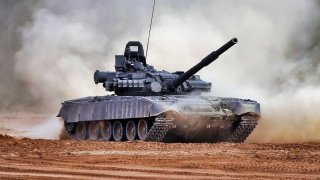Russia to Clear Landmines in Laos While Still Deploying Mines in Ukraine
There is some irony that Russia would go to such lengths to publicize its demining efforts in Laos due to how it has continued to deploy both anti-vehicle and anti-personnel mines in territory it controls in Ukraine.
The Russian International Mine Action Center has announced it is sending experts to the Lao People’s Democratic Republic (LDPR)—commonly just known as Laos—to help clear landmines. Mine clearing specialists have already reportedly cleared nearly 470 acres of land throughout six missions, while they disposed of more than 3,500 mines and other unexploded ordnance.
“In accordance with the decision of Russian President [Vladimir Putin], a unit of the International Mine Action Center will go to Laos in November of this year to carry out the seventh humanitarian operation to demine the territory of the country and train Lao specialists,” Major General Andrey Kruglov, head of the Karbyshev Military Engineering Academy, told state media outlet Tass.
Russia has claimed to have trained as many as 136 “deminers,” who are now engaged in mine clearance throughout Laos. The mines being cleared were reported to date from the Vietnam War (1964-1973)—however, fighting between the Hmong rebels and government forces has continued in the years since.
Due to the decades of fighting, Laos has earned the dubious distinction of being the “most bombed country in the world per capita.”
Ukraine—a Land of Mines
There is some irony that Russia would go to such lengths to publicize its demining efforts due to how it has continued to deploy both anti-vehicle and anti-personnel mines in territory it controls in Ukraine.
According to recent reports, Russian forces have deployed enough landmines and unexploded ordnance to cover upwards of a third of Ukrainian territory.
It isn’t just at the frontlines where this has been a problem.
After Russian forces had been driven back in parts of Ukraine, they left behind fields that were filled with a variety of mines and other unexploded ordnance. That makes it especially perilous for farmers to sow grain for the next harvest. According to a 2023 report from The Wall Street Journal, which cited data from the Ukrainian government, around 30 percent of the fields even around Kyiv have or had mines that needed to be cleared.
The land mines are often powerful enough to disable a main battle tank (MBT), and as a result, many farmers have been forced to wait for the fields to be cleared, or risk running over mines or other ordnance. In 2022, several farmers were killed by landmines.
The New York-based Human Rights Watch has repeatedly warned that Russia was using landmines and other ordnance “that are causing civilian casualties and suffering, as well as disrupting food production.”
Among the mines being used by the Kremlin’s forces are POM-2 and POM-3 mines that are reportedly dropped indiscriminately by aircraft or fired from specialized ground launchers. As Wired also reported, these are not buried but rather are scattered across large swaths of land. There is no reliable way to remotely track or disarm the mines. The POM-3 was never employed in combat until Russia used it in Ukraine. It was designed with a seismic sensor that triggers the mine when disturbed by footsteps. Once tripped, it jettisons an explosive payload to roughly head height before detonating.
Efforts to Clear the Mines
Just as Russia is now seeking to help clear mines in Laos, efforts are underway to clear mines in parts of Ukraine even as the fighting continues.
Earlier this year, efforts were being explored to employ artificial intelligence (AI) to identify regions impacted by mines.
Not all the efforts are so high-tech.
The Ukrainian military has been equipped with a number of the U.S.-made M58 MICLIC, a platform that entered service in 1988. It provides a lane eight meters by 100 meters (8.75 yards by 109 yards). The vehicles were sent to Ukraine as part of a security assistant package from the U.S. Department of Defense to counter the deployment of anti-personnel and anti-vehicle mines by Russian forces.
Civilians have also been exploring options.
Oleksandr Kryvtsov, a general manager at his agricultural company, decided he couldn’t wait for help from overworked official deminers/sappers to clear the fields around the village of Hrakove, Reuters reported in the spring of 2023.
The settlement, southwest of Kharkiv, was already largely devastated by the fighting. Before the war, about 1,000 people lived there, yet when it was liberated by Ukrainian forces, just 30 people remained—mostly living in basements and gutted buildings.
Kryvtsov is one of those who have returned and was determined to get back to work, but also knew that just sowing the fields could put his team at risk. Instead of waiting for official help, he designed a remote-controlled tractor that was fitted with armor panels from damaged Russian military vehicles.
Even as efforts are underway to demine parts of Ukraine, mines continue to be laid elsewhere—making for a Sisyphean task that won’t end even once the fighting stops.
Author Experience and Expertise: Peter Suciu
Peter Suciu is a Michigan-based writer. He has contributed to more than four dozen magazines, newspapers, and websites with over 3,200 published pieces over a twenty-year career in journalism. He regularly writes about military hardware, firearms history, cybersecurity, politics, and international affairs. Peter is also a Contributing Writer for Forbes and Clearance Jobs. You can follow him on Twitter: @PeterSuciu. You can email the author: [email protected].
Image Credit: Creative Commons and/or Shutterstock.

